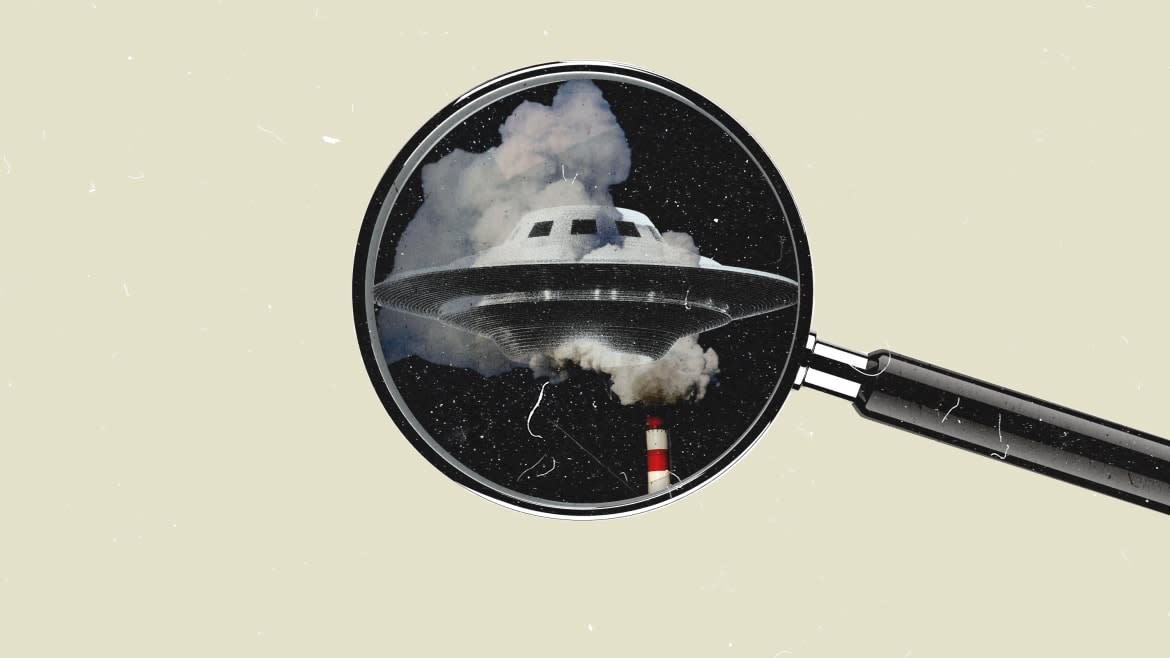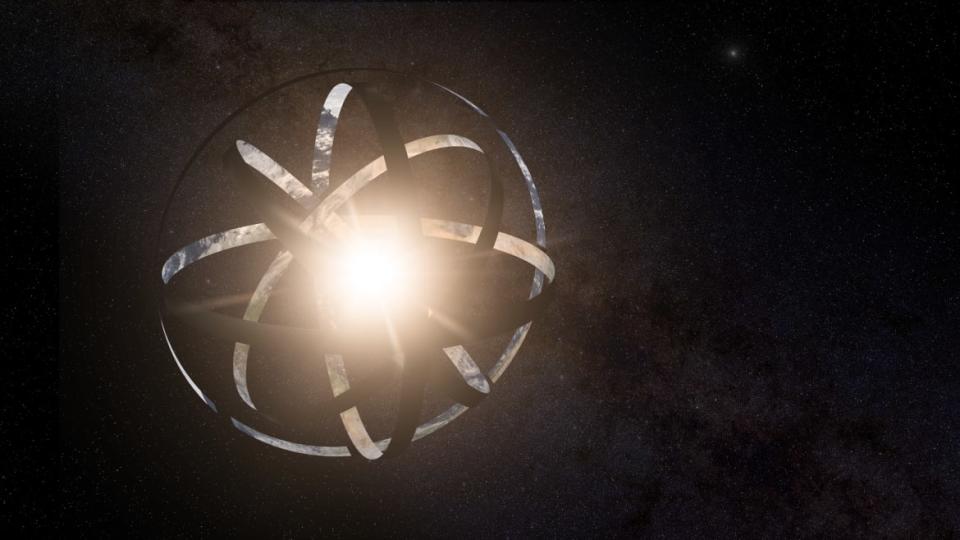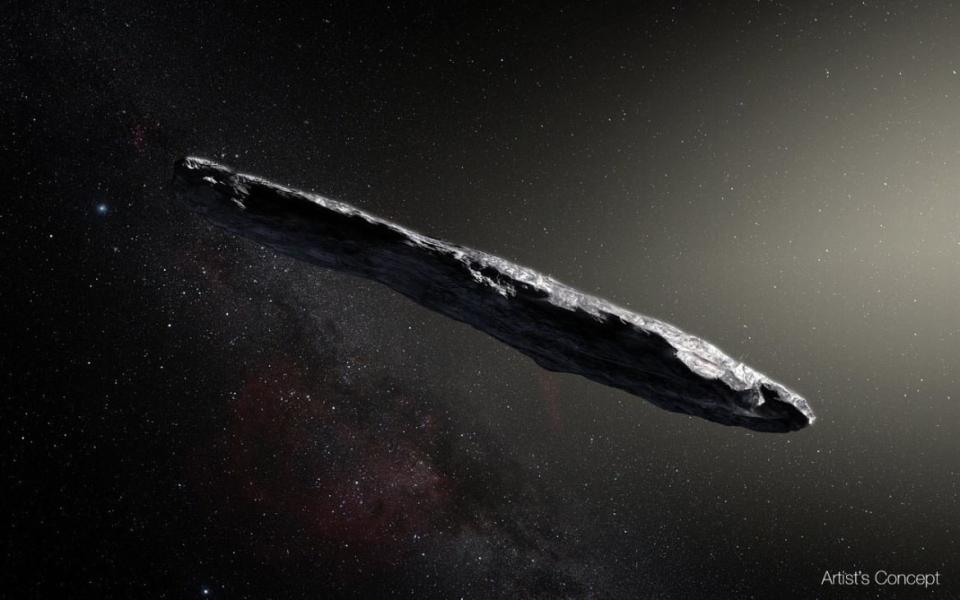The Alien Hunter’s Playbook Is Getting a Cutting-Edge Rewrite

- Oops!Something went wrong.Please try again later.
We’ve been searching for aliens in a serious way for 60 years now. That search is quickly expanding. And it’s compelling scientists to define, a lot more clearly, what evidence of an alien civilization might even look like.
The definition just a got a lot broader, thanks to a study posted May 31 that lists a bunch of new “technosignatures”—things in space that could signify the existence of alien technology and thus a whole civilization, either living or extinct.
Pollution from alien farms and factories. Giant inhabitable structures containing entire stars. Explosive bursts of radiation from the engines of high-tech spacecraft belonging to some other sentient species. Those are just some of the signatures on the new list, compiled by a team led by Jacob Haqq-Misra, an astrobiologist with the Blue Marble Space Institute of Science in Seattle.
The new study, which has been peer-reviewed and accepted for publication in the science journal Acta Astronautica, reads like an outline for the first act of a science-fiction film, where daring explorers glimpse fleeting evidence that humanity isn’t alone in the cosmos.
Our Efforts to Find Alien Life Have Gone Nowhere. This New Strategy Could Change That.
But the study isn’t fiction. Synthesizing the input of dozens of researchers across disciplines, it’s serious science—and it could help to guide multi-billion-dollar telescope surveys and space-probe missions for decades to come.
Outside experts praised the study. “There are no gaping holes in this list of technosignature search strategies,” Douglas Vakoch, who heads the METI International research organization in San Francisco, told The Daily Beast. “We have a comprehensive enough list that we can hit the observational ground running.”
There are holes, though perhaps small ones. Scientists who weren’t part of Haqq-Misra’s study are eager to add to the roster of technosignatures, all in order to give us the best chance of recognizing aliens if and when we finally come across them.
Still, even a somewhat incomplete tally of new technosignatures represents a big improvement. As a scientific discipline, the search for extraterrestrial intelligence—SETI—got its start back in the 1960s, when the first scientists began listening to the random noise of the galaxy, hoping to overhear a repeating, structured signal that could only come from intelligent beings.
In just the past couple years, we’ve expanded SETI to include a deliberate scan for the telltale flashes of artificial lasers—the kind aliens might use to communicate between planets or even propel certain kinds of spacecraft.
New telescopes, probes, instruments and search algorithms—some ready to deploy, others still in development—give us a reason to add a whole bunch more SETI signatures on top of radio signals and laser flashes. Think of the accepted list of these signatures as a sort of unofficial recognition guide for extraterrestrials, like a cosmic version of the guidebooks people carry when they go birdwatching.
The new technosignatures that Haqq-Misra and his co-authors endorse include: signs of industrial pollution in the atmosphere of a distant planet; the dense nighttime lights of sprawling alien cities; and the distinctive reflections of huge solar-power arrays that might power those cities.
Then there are the possible structures in space: alien space stations or, more grandly, gigantic space colonies or power generators partially or completely enclosing a faraway star. We should also look for the pulses of radiation from the engines of alien spacecraft traveling to or from some extraterrestrial homeworld or its offworld bases.
How Little Lasers Might Light Our Way to Extraterrestrials
Each of the 11 authors of the study—who run the scientific gamut from university astronomers to NASA advisers and private-sector researchers—has their own favorite technosignature. The thing they think we should look hardest for.
Haqq-Misra told The Daily Beast he’s most excited about pollution. Using new instruments—including NASA’s $10-billion James Webb Space Telescope as well as the Large Interferometer for Exoplanets, a probe in development in Europe—it’s possible to survey the atmospheres of distant exoplanets far beyond our own solar system.
Certain patterns of light could hint at the presence of pollutants like nitrogen dioxide, a possible sign of agriculture, industry and transportation technologies. “I am excited about atmospheric technosignatures because they are completely unexplored, and we can point to examples on Earth today of how technology has changed our atmosphere,” Haqq-Misra said.
Ryan Felton, an astrobiologist at Catholic University of America in Washington, D.C. and a co-author on the technosignature study, told The Daily Beast he’s most excited about the prospect of glimpsing a Dyson sphere or Dyson swarm. (Felton works with NASA but stressed he doesn’t speak for the space agency.)

A Dyson sphere, named for the late physicist Freeman Dyson, is a theoretical structure entirely encasing a star, like a vast eggshell. A highly advanced civilization might build something like that in order to create an unimaginably huge living space with essentially limitless power. A Dyson swarm is basically fragments of a Dyson sphere—separate inhabitable platforms spinning around a star.
Finding proof of such an advanced technology, perhaps using a telescope like the JWST, would be like looking into our own possible technological future, Felton said. “How would this exposure influence our own technological paths moving forward? Seeing our response to these scenarios would be fascinating.”
There are technosignatures that could be equally as useful as the ones Haqq-Misra and his coauthors cited but aren’t in the new study. Wade Roush, a popular science lecturer and author of the nonfiction book Extraterrestrials, mentioned one big omission. “It did strike me that the list doesn’t include interstellar objects crossing into our solar system,” he told The Daily Beast.
In other words, alien probes looking for us. Or derelict probes that tried looking for us potentially thousands or millions of years ago and ran out of power before endlessly drifting across the galaxy. E.T.’s space trash.

Artist’s impression of the interstellar asteroid ‘Oumuamua.
Some scientists, including Harvard physicist Avi Loeb, have stirred controversy in recent years by arguing that ‘Oumuamua—a strange, possibly 300-foot object that breezed through the solar system after arriving from interstellar space back in 2017—is a sign that intelligent extraterrestrials might exist. While most astronomers assume ‘Oumuamua is a rock with an odd trajectory, Loeb insisted we should investigate it as a possible spacecraft.
Ravi Kopparapu, a planetary scientist with NASA Goddard Space Flight Center in Maryland who is another of Haqq-Misra’s co-authors, told The Daily Beast we should expect the unexpected—regardless of what’s on the accepted list of signatures.
We could add a whole lot of technosignatures to our galactic search pattern and still come across something that feels like evidence of an alien civilization, but doesn’t fit any of our preconceived notions. “My suspicion is that the first detection might come from an unexpected source, an anomaly that doesn’t fit the data,” Kopparapu said.
Astronomers Investigating Curious Interstellar Rock for Signs of Extraterrestrial Technology
For that reason, it’s really important for SETI scientists to keep an open mind. “The greatest challenge we face in finding alien technosignatures is to imagine extraterrestrial civilizations that are radically different from our own civilization,” Vakoch said.
Haqq-Misra conceded that we can’t even begin to guess whether, and how, we might finally detect extraterrestrials, even after all these decades of looking. “I cannot say anything about the likelihood of finding any particular technosignatures, as we simply do not have any idea as to how common life and technology are in our galaxy,” he said.
The only way to guarantee we never find E.T. is to not look, of course. “This is the reason we need to search!” Haqq-Misra said. As we search, it’s handy to have an alien-recognition guide in hand. And handier still to keep that guide as up-to-date as possible.
Get the Daily Beast's biggest scoops and scandals delivered right to your inbox. Sign up now.
Stay informed and gain unlimited access to the Daily Beast's unmatched reporting. Subscribe now.

